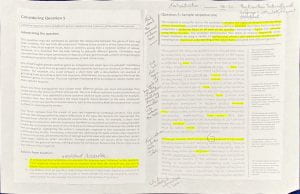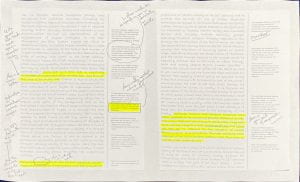The following question was taken from the 2019 Semester 1 Year 12 ATAR English examination produced by the ETAWA:
Create a persuasive text aimed at a teenage audience which starts with an anecdote.
Question Deconstruction and Planning
As with all questions, we need to break it down and make sure that we understand what the question is asking of us. We need to understand what the key discriminators are and get our thoughts organised before we begin writing.
Let’s break this question down…
- ‘persuasive text’- this means the text of a speech that might be performed in front of a teenage audience. This is your AUDIENCE.
- ‘teenage audience’- while this is your AUDIENCE, you also need to consider the CONTEXT of your persuasive text. Is it performed at a school assembly? An awards night? At a conference where many schools have congregated?
- PURPOSE- what is your speech going to be about? What is the content? Is it appropriate and relevant to a teenage audience?
- Do you know what an ‘anecdote’ is? (Definition- a short story or an interesting or entertaining incident)
Possible Topics
Climate change
#Metoo
Gender equality… Yeah… this one.
Social media
Instagram and its effect on body image
Cyberbullying
University- the first year
Environmental issues- recycling etc.
Race
Cultural change
Lowering the age to vote
Sample Response (Gender Equality)
I lead a very glamorous life. VERY. Some might even say that I’m living the dream and I guess I am. So… here’s a real, authentic and honest account of a shopping trip to Coles. I was pushing my fully-laden trolley down the cleaning products isle when a woman remarked to me that I was very brave. It took me a moment to process what she said, before she pointed at my bright pink fingernails. My daughters often ‘treat’ me to a manicure and this week, their chosen colour was hot pink. And there I was in Coles not really aware of anything much, other than trying to get the shopping done with minimum fuss. My only response was a muttered, stuttered ‘thanks’ and I continued shunting my recalcitrant trolley onwards. But then I thought… ‘How the hell are my hot pink fingernails a symbol of bravery?’ Have I reached the apex of bravery by being seen IN PUBLIC with bright pink fingernails? And what would the people in war-torn countries, asylum seekers on perilous seas in rickety boats or a soldier with a gun in their hand think?
In truth, the answer is perfectly simple and it’s ludicrous to think that a middle-aged man strutting his stuff with hot pink fingernails is in anyway brave at all. It isn’t. Or, at least, it shouldn’t be as the gender binary is slowly being challenged and contested. As it should be. We are gathered here today to promote not only gender equality but to show our authentic face to the world and to make no apologies for it You, the adults of tomorrow, have an opportunity to construct the world in your image and what a joyous image it will be if a teenager doesn’t feel guilty about their identity, that a young person doesn’t feel guilty about who they are, or feel that they have to live a lie. Gender identity is one of the most pressing issues facing teenagers today. This convention of young people here assembled has the power to ensure no-one lives a lie anymore.
I’m horrified every time I walk into a toy shop. The stark reality is that the gender binary exists- in all its forms- whenever I’m asked to buy a present for one my daughter’s friends. The girls’ section is littered, splashed, dominated by pinks and purples, dolls and domesticity, glitter and gloss. The boys’? construction, cars, tools, science stuff. This is outrageous. Do we even stop to consider that one day our boys might be parents and that looking after a baby might be a skill worth learning? Or at least being a caring human being. I find it all quite exhausting. It really doesn’t challenge anyone’s construction of gender if a boy chooses to play with a doll, or wants to do ballet and why should it anyway?
Planning- Rest of Response
My sample response would include the following sections if I was to continue writing…
I’d go on to look at Billy Elliot (film) as an example.
Might offer a refutation/rebuttal.
Perhaps find some statistics to back this up. That the gender binary is being contested.
An appeal to our sense of values… that we want people to grow up to be their best selves, to be empathetic, to judge people on the ‘content of their character’, not by how they look.
Then I’d end with an appeal to paint your nails with pride, dance like no-one’s watching and to live an authentic self.
Teaching and Learning Points
- I deconstructed the question BEFORE I began writing my response so that I had a very clear sense of direction. It’s important that you have a focused approach, particularly in deciding what the PURPOSE of your persuasive text is going to be BEFORE you begin writing.
- I SHOW my audience my context, audience and purpose… I don’t TELL them it. There’s a difference.
- First two sentences are a weak attempt at humour. I wanted to contrast the ‘glamourous life’ and ‘living the dream’ with something very mundane… shopping at Coles.
- ‘fully-laden trolley’ is storytelling, it’s being descriptive and setting the scene for the audience. It adds to the narrative.
- The anecdote starts off innocently and then changes into something more serious… challenging the notion of ‘bravery’.
- There’s a rhetorical question in there to show my incredulity.
- Notice the short sentences in the second paragraph to make my point in a short, sharp manner. They’re used for impact and to make the point to-the-point.
- Notice the repetition in this paragraph to reinforce my message.
- Notice the alliteration of ‘live a lie’ to reinforce my message.
- Final sentence of the second paragraph gives the context of the persuasive text.
- Second paragraph becomes more emotive.
- I use hyperbole in the first sentence of the third paragraph. Being ‘horrified’ in a top shop is a gross exaggeration used to prove my point.
- There’s a few triplets in this paragraph.
- Note the use of alliteration to unify the imagery I use at this point.
- More emotive language- ‘outrageous’.
- The planning of the rest of the response shows that I would use some facts to support my argument, that I would appeal to my audience’s values and that I would offer an appeal at the end to not judge people by their appearance but by the ‘content of their character’. This, by the way, is an intertextual reference to Martin Luther King’s ‘I Have a Dream’ speech.
As you can see, I’ve used a reasonable range of persuasive devices (rhetorical questions, triplets, emotive language, alliteration, anecdotes, repetition) as well as SHOWING my audience my context, audience and purpose without TELLING them it. The planning shows that I’d want to offer further proofs (facts and an appeal to values/justice) before getting to the emotional climax of my speech and offering a solution or, at least, a challenge to the audience to go out into the world to live their best lives.




